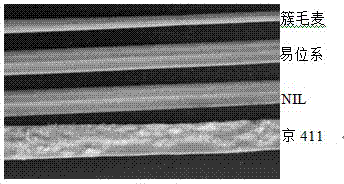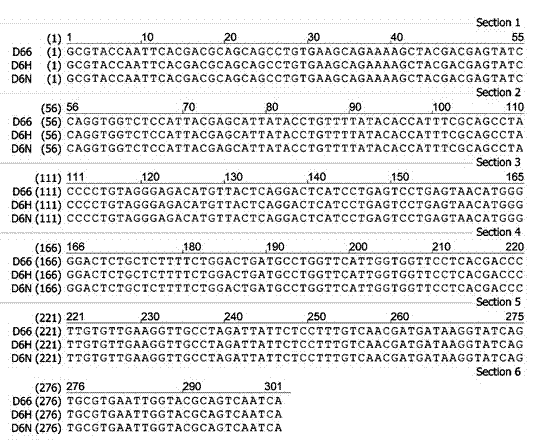Sequence of dasypyrum villosum 6VS DNA permeating into powdery mildew resistant near-isogenic line of wheat and application
A near-isogenic, powdery mildew-resistant technology, applied in the field of agricultural biotechnology engineering, can solve the problems of tracking, that is, the donor gene detection report is less, the cultivation time is long, and it is easily affected by development, environmental conditions and human factors.
- Summary
- Abstract
- Description
- Claims
- Application Information
AI Technical Summary
Problems solved by technology
Method used
Image
Examples
Embodiment 1
[0068] Preparation of near-isogenic lines and identification of disease resistance:
[0069] The preparation of the near-isogenic line of the present invention: the test material, the common cultivated wheat Jing 411 ( Triticum aestivum , 2N=6X=42, AABBDD), excellent agronomic traits, but susceptible to powdery mildew; powdery mildew-resistant wheat-Triticum aestivum chromosome translocation line 6VS.6AL (T6VS.6AL), 6VS in the translocation line comes from the cluster Wool wheat ( Haynaldia villosa 2N=2X=14, VV). The near-isogenic line Jing411 / 6VS.6AL / 京411 prepared with 6VS.6AL as the disease-resistant donor parent and Jing411 as the reincarnation parent 7 (Near-isogenic Lines, NIL). The process is T6VS.6AL×京411 hybridization, and F 1 All are resistant to powdery mildew, backcrossed with Jing 411 for 7 generations, and self-bred for the first generation to produce powdery mildew resistant near-isogenic lines 411 / 6VS.6AL / 京411 7 ; For each cross and backcross, disease-resistant s...
Embodiment 2
[0071] AFLP detection of NIL derived from 6VS powdery mildew resistance gene
[0072] The wheat DNA was extracted using the CTAB method, with a slight modification: Weigh 0.2g of young leaves and cut them into a mortar, add liquid nitrogen to quickly grind them into powder and transfer to a 5ml centrifuge tube, add 1ml DNA extraction buffer (0.1M Tris· Cl, pH8.0; 0.02mM EDTA, pH8.0; 1.4M NaCl; 4%CTAB; 1%PVP), water bath at 65℃ for 90min, shaking every 10min during this period; centrifugation at 10000rpm, 4℃ for 10min, take the supernatant In a new 5ml centrifuge tube, add an equal volume of phenol-chloroform-isoamyl alcohol (25? 24 ?1) and gently mix upside down. Centrifuge at 10000 rpm for 10 min. Pipette the supernatant into a new 5ml centrifuge tube and add again. Equal volume of phenol-chloroform-isoamyl alcohol extraction, centrifugation at 10,000 rpm for 10 minutes, suck the upper water phase into a 2ml centrifuge tube; add an equal volume of cold isopropanol, and place it ...
Embodiment 3
[0075] Obtained molecular evidence from 6VS in NIL
[0076] Using the AFLP method, molecular marker screening was carried out in V. vulgaris (VV), translocation line T6VS.6AL, NIL, and recurrent parent common wheat Jing 411. In this experiment, 15 AFLP profiles ( Figure 5 ), of which type I is the AFLP pattern that exists in T. vulgaris, T6VS.6AL, NIL and reincarnation parents. The frequency of this AFLP pattern is 3.8%. Triticum aestivum is a wild relative of common wheat, which proves that they have certain homology in the type Ⅰ AFLP genome, but have no correlation with the resistance to powdery mildew; type II: Triticum aestivum does not exist in T6VS.6AL Compared with common wheat, T6VS.6AL and NIL have the 6VS chromosomes derived from Triticum acuminata. Obviously this type of AFLP profile has nothing to do with 6VS, but is derived from common wheat. Wheat genome; type Ⅲ: only exists in P. tutus, not in T6VS.6AL, NIL, and common wheat. Since T6VS.6AL and NIL do not exis...
PUM
 Login to View More
Login to View More Abstract
Description
Claims
Application Information
 Login to View More
Login to View More - R&D
- Intellectual Property
- Life Sciences
- Materials
- Tech Scout
- Unparalleled Data Quality
- Higher Quality Content
- 60% Fewer Hallucinations
Browse by: Latest US Patents, China's latest patents, Technical Efficacy Thesaurus, Application Domain, Technology Topic, Popular Technical Reports.
© 2025 PatSnap. All rights reserved.Legal|Privacy policy|Modern Slavery Act Transparency Statement|Sitemap|About US| Contact US: help@patsnap.com



